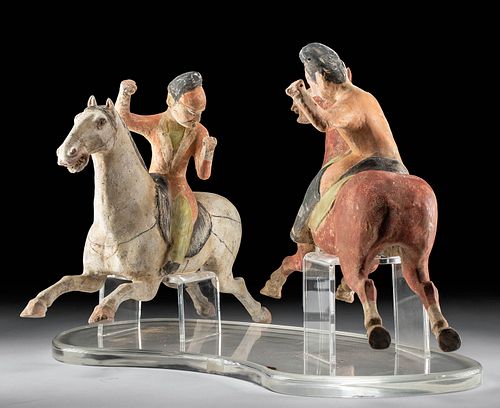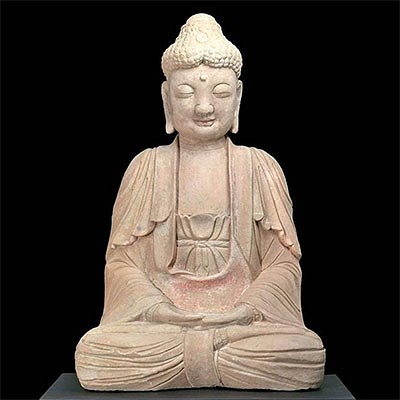Chinese Tang Dynasty Pottery Polo Players ex Sotheby's
Lot 79
About Seller
Artemis Fine Arts
686 S Taylor Ave, Ste 106
Louisville, CO 80027
United States
Selling antiquities, ancient and ethnographic art online since 1993, Artemis Gallery specializes in Classical Antiquities (Egyptian, Greek, Roman, Near Eastern), Asian, Pre-Columbian, African / Tribal / Oceanographic art. Our extensive inventory includes pottery, stone, metal, wood, glass and textil...Read more
Categories
Estimate:
$9,000 - $12,000
Absentee vs Live bid
Two ways to bid:
- Leave a max absentee bid and the platform will bid on your behalf up to your maximum bid during the live auction.
- Bid live during the auction and your bids will be submitted real-time to the auctioneer.
Bid Increments
| Price | Bid Increment |
|---|---|
| $0 | $25 |
| $300 | $50 |
| $1,000 | $100 |
| $2,000 | $250 |
| $5,000 | $500 |
| $10,000 | $1,000 |
| $20,000 | $2,500 |
| $50,000 | $5,000 |
| $100,000 | $10,000 |
| $200,000 | $20,000 |
About Auction
By Artemis Fine Arts
Feb 18, 2021
Set Reminder
2021-02-18 10:00:00
2021-02-18 10:00:00
America/New_York
Bidsquare
Bidsquare : Exceptional Antiquities, Asian, Ethnographic
https://www.bidsquare.com/auctions/artemis-gallery/exceptional-antiquities-asian-ethnographic-6373
Museum-worthy examples of Egyptian, Greek, Roman, Etruscan, Near Eastern, Far East / Asian, Pre-Columbian, African / Tribal, Oceanic, Native American, Spanish Colonial, Russian, Fossils, Ancient Jewelry, Fine Art, so much more! Artemis Fine Arts info@artemisfinearts.com
Museum-worthy examples of Egyptian, Greek, Roman, Etruscan, Near Eastern, Far East / Asian, Pre-Columbian, African / Tribal, Oceanic, Native American, Spanish Colonial, Russian, Fossils, Ancient Jewelry, Fine Art, so much more! Artemis Fine Arts info@artemisfinearts.com
- Lot Description
East Asia, China, Tang Dynasty, 618 to 907 CE. A pair of ceramic polo players, each with a well-modeled figure upon a galloping horse with finely painted details and nice remaining pigments. The sculptures emphasize a powerful sense of movement and athletic balance. Note how the horse’s legs are extended front and back - a pose known as ventre a terre - while the rider twists from the waist with arms raised to mightily strike the ball. Size: figure & white horse measures 14.75" L x 11.75" H (37.5 cm x 29.8 cm); together the ensemble measures 13.375" H (34 cm) on included custom stand.
While a 3rd century CE poem by the Chinese poet Cao Zhi mentions the act of hitting a ball on horseback, and a mural in the late 6th century tomb of Xu Minxing in Shandong province depicts a man mounting a horse while holding what look like polo sticks, the first very clear written evidence of the game of polo in China dates to the Tang dynasty, when the game was called jiqiu (meaning strike ball). In the present day, the game is usually called maqiu horse ball) or damaqiu (strike horse ball). Both men and women of the Tang court played polo; however, the riders on the horses in this lot are both male. Two Tang emperors in particular, Taizong (reigned 626-649 CE) and Xuanzong (reigned 712-756 CE) favored the game of polo. They encouraged young men of the court to play it, because the skills involved could be applied to military activities.
Tang dynasty poets were also inspired by polo. The literatus Han Yu wrote a poem entitled Poem to Commander Zhang at the meeting of the Bian and Si Rivers" which describes a polo field that was 1000 steps long, with low walls on three sides, and called the ball used in the game "the divine bead". The poem describes the game occurring before sunrise on a cold autumn morning; drums making a thunderous sound when the red flags are raised to start the match; as well as the intense competition between the players and the excitement of the spectators. At the end of the poem, Han Yu declares that polo is not a game for mere fun, but is actually one devised for military training. This said, scholars also played polo during the Tang dynasty and successful candidates in the national civil service examinations held a polo tournament to celebrate.
Provenance: ex-Freeman Auctions, June 19 2020, Lot 106; property from a European-American collection, acquired from Sotheby's New York, September 15, 1999, lot 77
All items legal to buy/sell under U.S. Statute covering cultural patrimony Code 2600, CHAPTER 14, and are guaranteed to be as described or your money back.
A Certificate of Authenticity will accompany all winning bids.
We ship worldwide and handle all shipping in-house for your convenience.
#157767Figures are repaired from several pieces with limbs and heads reattached. Surfaces show normal age wear but have wonderful remains of pigmentation and scattered mineral deposits. Implements (polo sticks) held in hands are missing.Condition
- Shipping Info
-
All shipping is handled in-house for your convenience. Your invoice from Artemis Gallery will include shipping calculation instructions. If in doubt, please inquire BEFORE bidding for estimated shipping costs for individual items.
-
- Buyer's Premium



 EUR
EUR CAD
CAD AUD
AUD GBP
GBP MXN
MXN HKD
HKD CNY
CNY MYR
MYR SEK
SEK SGD
SGD CHF
CHF THB
THB

















